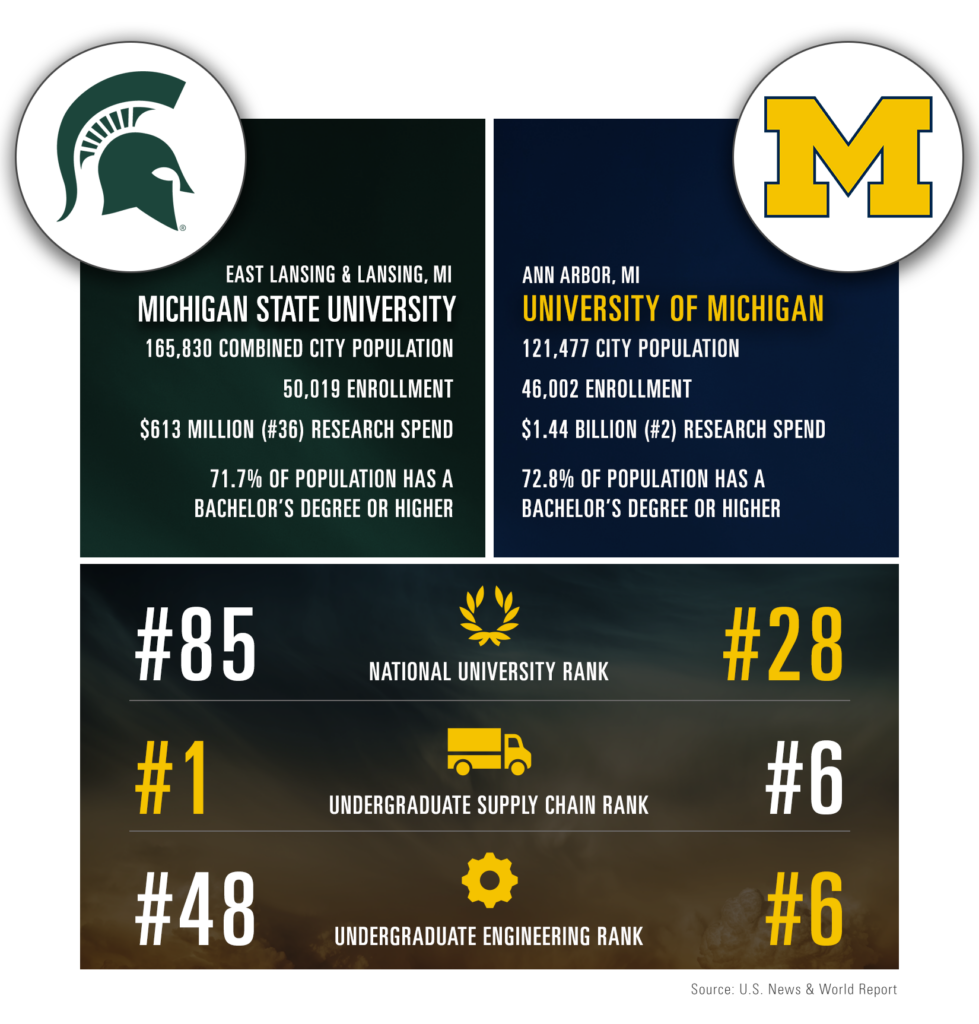
Our football blog series is back for the third straight year! As before, we’ll use the football season as an impetus to compare Ann Arbor to cities and towns on this year’s schedule. And the question is always – how does Ann Arbor compare to other college towns in the US?
Can you hear the drumbeats? The University of Michigan vs. Michigan State game is this weekend; a time-honored tradition of competition for the Paul Bunyan trophy. (And treacherous footing for a comparison…but here we go anyway!) The teams first played each other in 1898, and Michigan leads the all-time series 69:5:36. HOWEVER, the Wolverines have only won two games in the last 10 years. I’m sure they are looking for redemption after last year’s upset in the final minutes.
Unlike our usual comparisons, these two cities are in the same state, which both simplifies and complicates the equation. Some variables are held constant, while others are placed in a spotlight. Considering the delicate balance, there is more context to discuss this week than usual:
- Michigan State is located in East Lansing, a separate city (statistically and municipally) from Lansing, though they are clearly interconnected.
- Lansing is the State Capital, an oddity among metropolitan areas where the major local industry is the state government.
- East Lansing is a town of approximately 50,000, while Lansing is closer to 120,000. Their combined total is larger than Ann Arbor, though their distance from the major metropolitan area of Detroit is greater.
Not surprisingly, the two regions that include Ann Arbor and Lansing/East Lansing are the two most educated regions in the state of Michigan and account for approximately 50% of new construction permits in the state (a good indicator of economic growth). (source)
In terms of the state’s labor force, both universities clearly contribute high-quality talent. According to surveys conducted by the career services centers at each school, 64% of MSU grads and 33% of U of M grads remain in Michigan after graduation.
As usual, this stat comes with caveats: U-M matriculates more out-of-state and international students, which could drive the percentage down. Also, this statistic doesn’t necessarily consider the alumni who return to Michigan some years later. (This statistic could have an entire blog post unto itself!)
Overall, it’s useful to contemplate the educational and post-educational pathways of the workforce in Michigan.
The football rivalry between Michigan State and the University of Michigan may be historic and traditional, but as inhabitants of the same state, we all benefit from their continued academic and athletic prowess.
*For the data heads out there noticing that enrollment > population for East Landing, population in the Census is usually calculated in a town by excluding college students – check out this article to go deep into the rabbit hole of how that can be problematic. We’ll be waiting right here when you get back…

Data Dive
Where do we get our numbers? And what do they mean?
- Population comes from the US Census, 2017 Population Estimates. Check out Ann Arbor’s data here.
- Enrollment comes from each university’s website (what they report on enrollment).
- Research spend comes from the National Science Foundation Rankings by Total R&D Expenditures.
- Educational attainment comes from the US Census 2012-2016 American Community Survey 5-Year EstimatesWe look specifically at the population over the age of 25, and the highest level attained. Check out Ann Arbor’s data here.
- The rankings come from US News and World Report unless otherwise mentioned.